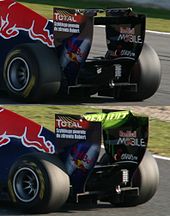
In motor racing, the drag reduction system (DRS) is a form of driver-adjustable bodywork aimed at reducing aerodynamic drag in order to increase top speed and promote overtaking. It is an adjustable rear wing of the car, which moves in response to driver commands.[1] DRS often comes with conditions, such as the requirement in Formula 1 that the pursuing car must be within one second (when both cars cross the detection point) for DRS to be activated.
DRS was introduced in Formula One in 2011 and is planned to used until the 2025 season. The use of DRS is an exception to the rule banning any moving parts whose primary purpose is to affect the aerodynamics of the car. The system is also used in the Formula Renault 3.5 from 2012 until it folded in 2017,[2] Deutsche Tourenwagen Masters since 2013,[3] Super Formula since 2014, GP2 Series later FIA Formula 2 Championship since 2015, GP3 Series later FIA Formula 3 Championship since 2017. An adjustable wing was also used by the Nissan DeltaWing at the 2012 24 Hours of Le Mans, although with free usage.
DRS is set to be removed in Formula One for the 2026 season, as it will be replaced with an "active aerodynamics" system under the new 2026 regulations.[4]
- ^ "2011 F1 Technical Regulations, Section 3.18" (PDF). argent.fia.com. 8 March 2011. Retrieved 8 May 2024.
- ^ New Formula Renault 3.5 racer unveiled at Silverstone – Autoblog, 24 August 2011
- ^ DTM's DRS system will be limited at Brands Hatch – Mattias Ekstrom – Autosport, 14 May 2013
- ^ Cite error: The named reference
:0was invoked but never defined (see the help page).